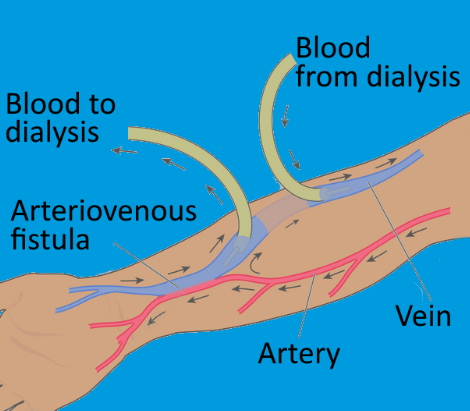Dialysis Access Care
DIALYSIS ACCESS CARE Q & A
What Is Dialysis Access Care?
Dialysis access allows blood to travel between the patient and the dialysis machine via soft tubes. An access is placed by a minor surgery. Dialysis treatments will be most beneficial when access is functioning well. Dialysis access care refers to treatments available to improve and restore blood flow and improve access function.
When Is Dialysis Access Care Necessary?
If an AV fistula or AV graft clots or narrows, there will be a decreased amount of blood flowing through the access. A dysfunctional access can delay dialysis. A patient undergoing dialysis will grow accustomed to the normal sounds of dialysis and will often recognize when the access is not functioning properly. Minimally invasive dialysis access care procedures will restore access blood flow.
How Is the Access Problem Diagnosed?
A fistulagram or graftogram is a study performed to evaluate the function of the fistula or graft. By analyzing the results, physicians can diagnose the dialysis access issue. The fistula or graft may have narrowed or been blocked, thus decreasing blood flow, and preventing scheduled dialysis.
How Is A Dysfunctional Dialysis Access Treated?
Minimally invasive treatments to improve dialysis access function include:
- De-clots (thrombectomy)
- Tunneled hemodialysis catheter placement/exchange/removal
- Peritoneal dialysis catheter placement
- Percutaneous fistula creation

Treatments for Dialysis Access Care
Interventional radiology techniques allow physicians to see locations of veins and vessels in patients. This enables a determination of the best placement for catheters and fistulas and grafts. Obstacles to blood flow can be detected and corrected, reestablishing good blood flow so that dialysis can resume.
Declots/Thrombectomy
Thrombectomy is a minimally invasive procedure used to de-clot the fistula or graft access and reestablish blood flow. Clots can occur when blood does not flow smoothly through the access, and it coagulates. Or, fibrin deposits develop in the access, causing a blockage of blood flow.
During thrombectomy, physicians use x-ray imaging to guide a catheter with clot/fibrin dissolving medication to the source of the blockage. Blood flow will be restored, and dialysis can be resumed.
Tunneled Hemodialysis Catheter Placement/Exchange/Removal
When a patient is new to dialysis, access may be needed before the fistula or graft is matured and ready for use. A tunneled hemodialysis catheter is placed across the collarbone enabling usable access so dialysis is not delayed. This procedure is minimally invasive.
Peritoneal Dialysis Catheter Placement
Peritoneal dialysis (PD) catheter placement is a minimally invasive procedure. Physicians use x-ray imaging to direct the placement of a catheter through the abdomen and peritoneal membrane that lines the abdominal wall.
Percutaneous Fistula Creation
Percutaneous refers to a procedure in which inner tissues or vessels are reached by needle-puncture of the skin, versus traditional surgical incisions. Percutaneous fistula creation uses a special device to create the fistula without surgery. In the procedure, physicians pass a small wire and catheter within the vessels to make the fistula.
What Are the Benefits of Dialysis Access Care?
A functioning access allows patients to resume dialysis quickly, often without missing a scheduled session. Dialysis access care using minimally invasive procedures to correct blood flow offers several benefits:
Dr. Jilbert Eradat provides minimally invasive dialysis access care to enable quick resolution to blood flow dysfunctions and access placements, getting patients back to the dialysis treatment needed.

631 West Avenue Q, Suite A
Palmdale, CA 93551
Phone 661-480-5956
Fax 661-480-5976
Hours
- Monday–Friday
8 am – 5pm
Resources
Connect
